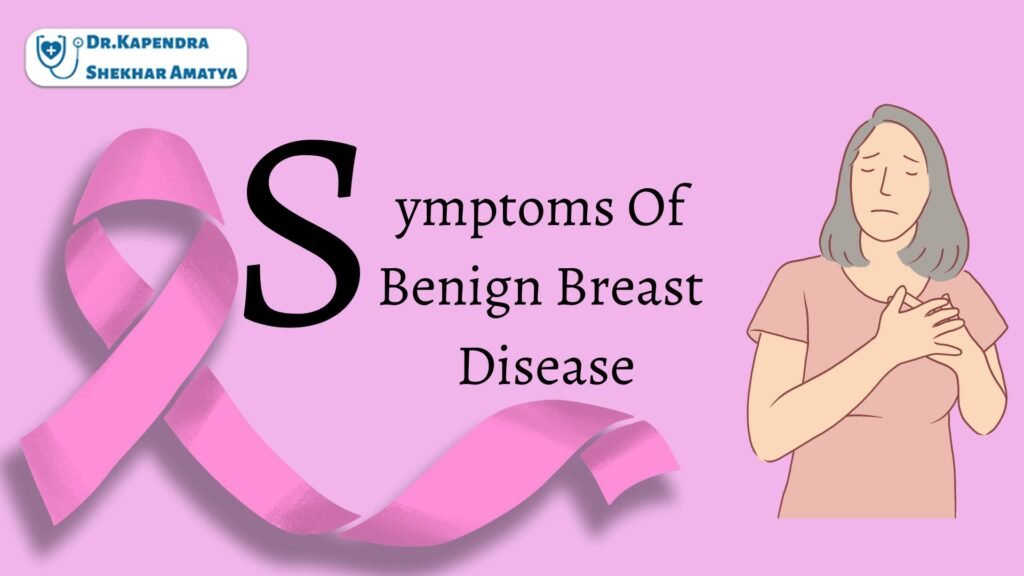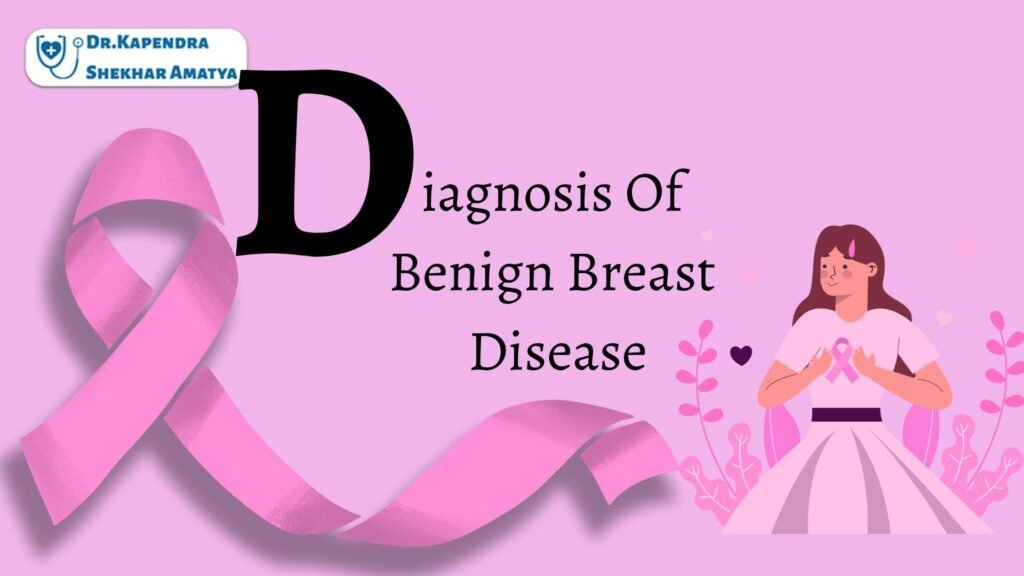Table of Contents
ToggleIt is not uncommon for people to think that breast cancer is their first thought when they feel a lump in their breast. It is most commonly the case that breast lumps are benign, meaning they are not cancerous. There is no gender difference in benign breast lumps. It is referred to as benign breast disease. You may develop breast cancer later in life if you suffer from these breast changes. Despite this, these changes do not pose a threat to the recipient’s life or cause cancer.
It is more likely that you will get breast lumps if you suffer from benign breast disease. Although finding a lump can be frightening, these breast changes are harmless. The risk of breast cancer increases with certain breast diseases. Any breast lumps or changes should be reported to your healthcare provider. There is no need to treat most noncancerous lumps.
Causes of Benign Breast Disease:
Several factors can lead to benign breast conditions. Among them are the makeup of your breasts, your age, and any hormonal issues you may be experiencing. Infection, thyroid disease, menopause, hormonal therapy, and birth control pills can all cause them. You can often determine the exact cause based on your specific diagnosis. A hormone imbalance leads to male breast problems such as gynecomastia. A severely overweight person can also suffer from this condition due to hormone therapy, some diseases, or a combination of those factors.
Symptoms of Benign Breast Disease:

While doing a breast self-exam, getting dressed, or showering, you may notice breast changes or a lump. A mammogram may be able to detect these changes. Breast lumps are not the only signs of benign breast disease; other signs include:
• Pain in the breast
• The nipple discharge
• A change in the size, shape, or contour of the breasts
• Nipples with inversions, creases, or scaly skin
• Breasts that are dimpling, puckering, or scaly.
Major Types of Benign Breast Diseases:

An abnormal growth or other change in the breast tissue that is not cancerous is known as a benign breast condition. There is often a fear associated with benign breast conditions since the symptoms are often similar to those of breast cancer. It is possible to feel a lump or see nipple discharge, or your mammogram might show something that needs to be examined further.
Here are some common benign breast diseases:
• Breast Cysts
• Fibroadenoma
• Calcifications
• Central Intraductal Papilloma
• Papillary Apocrine Change.
Breast Cysts:
Fluid fills breast cysts, which can be round or oval in shape. It is estimated that 25% of all breast masses are cysts. There is no increase in the risk of breast cancer associated with breast cysts. Depending on their size, they can be very small or large enough to detect on imaging tests or feel through the skin. There is a wide range of cyst types.
It’s most common for women in their 40s to develop cysts, but they can happen at any age. It is more common for women to develop multiple cysts simultaneously or gradually over time. Cysts that can be felt are usually round and quite mobile under the skin if they are large enough to be felt. The breast can also become painful, tender, or lumpy due to cysts. There may be times during the menstrual cycle when those symptoms worsen and when they get better.
Fibroadenoma:
The most common benign breast tumor is a fibroadenoma, which does not increase your risk of developing breast cancer. In general, fibroadenomas occur in younger, premenopausal women, although they can occur at any age. Fibroadenomas are usually well-defined, round, or oval-shaped, feel rubbery, and are not painful. Instead of being stuck in one place under the skin, it moves easily under the skin when you touch it.
Fibroadenomas can grow or shrink in size over time. There is no typical fibroadenoma size, but they can range from the size of a marble to 2.5 cm in diameter. Fibroadenomas that grow to 5 cm or more are called giant fibroadenomas. Menopause often causes fibroadenomas to shrink, while pregnancy or hormone therapy can make them bigger.
Calcifications:
A calcium deposit appears on a mammogram as a bright white speck or dot on the soft tissue background of the breast. X-rays from mammograms are readily absorbed by calcium. Ultrasounds and MRIs do not typically detect calcium deposits. Mammograms commonly reveal calcifications, and they become more prevalent after menopause.
Calcium in your diet has nothing to do with calcifications. Additionally, they cannot lead to breast cancer. As a result, they serve as markers for underlying processes in the breast tissue. It is usually benign in most cases. Calcifications can occur in people as they age due to benign cell changes. Calcium can sometimes be secreted onto ducts by glandular cells in the breast.
Central Intraductal Papilloma:
Intraductal papillomas are benign cancers that grow within the breast duct. There are several types of central intraductal papillomas; they usually occur as one growth, but they can also appear as multiples. It is not associated with an increase in breast cancer risk if a central papilloma has normal-looking cells.
Papillomas are usually small, tan-pink growths less than 1 cm in diameter, but they can grow up to 5 cm or 6 cm in diameter. Women between the ages of 30 and 50 are most likely to develop it. Screening mammograms sometimes detect it. In addition, it may be diagnosed when you experience symptoms such as nipple discharge or a lump within your nipple. A spontaneous discharge of blood or clear fluid often occurs in this situation.
Papillary Apocrine Change:
An abnormality of the glands lining the breast ducts is called papillary apocrine change. The cell wall is filled with a grainy gel-like substance, indicating an overgrowth of cells with apocrine characteristics. It is common for cells to have snout-like growths.
Breast cancer risk is not increased by papillary apocrine changes. Breast cancer can sometimes cause these changes as well. As well as breast cancer, radial scars, and atypical hyperplasia can increase the risk of developing these conditions. It is important to note that papillary apocrine changes are not associated with an increased risk on their own.
Diagnosis of Benign Breast Diseases:

You may notice that your breasts are different. An examination or screening by your doctor may uncover the problem. You will be asked questions by your doctor about what you are experiencing. An examination of your breasts and a question about your family history of breast cancer will be conducted by your doctor. It may be necessary to conduct further testing to rule out cancer. Mammograms and ultrasounds may be used in these tests. Your doctor uses ultrasound technology to examine the inside of your breasts by moving a small wand-like device around them.
A fine needle biopsy or aspiration may also be recommended by your doctor in addition to surgery. To remove a sample of tissue or fluid from a lump, a thin needle is inserted into the lump through a syringe. Biopsies and surgery are performed in hospitals. An examination of your biopsy will be conducted in a laboratory. Your doctor will receive all test results. The results will be notified to you by phone. A follow-up physical exam should occur in 4 to 6 weeks if a fine needle biopsy and physical exam revealed that the breast condition is benign.
How to Prevent Benign Breast Disease?
The chances of developing benign breast disease aren’t very high. In addition to lowering cancer risk, these actions may also help detect cancer early when it can most easily be treated:
• Screen your breasts regularly with mammograms
• Examine your breasts to become familiar with how they feel and look
• Weight management
• Make sure you exercise regularly
• Maintain a healthy diet
• Moderate or no alcohol consumption
• Get rid of your smoking habit
• Consider using hormone replacement therapy less often
• Use a nonhormonal birth control method instead of hormones.
When to See an Oncologist in Nepal?
Talking about seeing an oncologist in Nepal, you can do that as soon as you experience any difference in your breast. It can be a lump or any other particular change. You can make an appointment with a medical or surgical oncologist in Nepal. Your breast cancer oncologist will help you diagnose and treat cancer effectively. The breast cancer doctor will also help you in every phase of your cancer treatment. As per the top surgical oncologist in Nepal, Dr. Kapendra Shekhar Amatya, it is best suggested to make your doctor your closest friend when it comes to treating cancer. He also says that the breast cancer surgeon should know every single detail about you to help you overcome it much more easily.
What is a Breast Cancer Surgery in Nepal

MS (NMC Regd.2902)
Head of the Department, Sr.Consultant Surgical Oncologist at Nepal Cancer Hospital and Research Center
Director: Breast Cancer Program
Interest: Breast Cancer Surgery, Gastro Intestinal Cancer Surgery (Stomach and Colo-Rectal Cancer)


